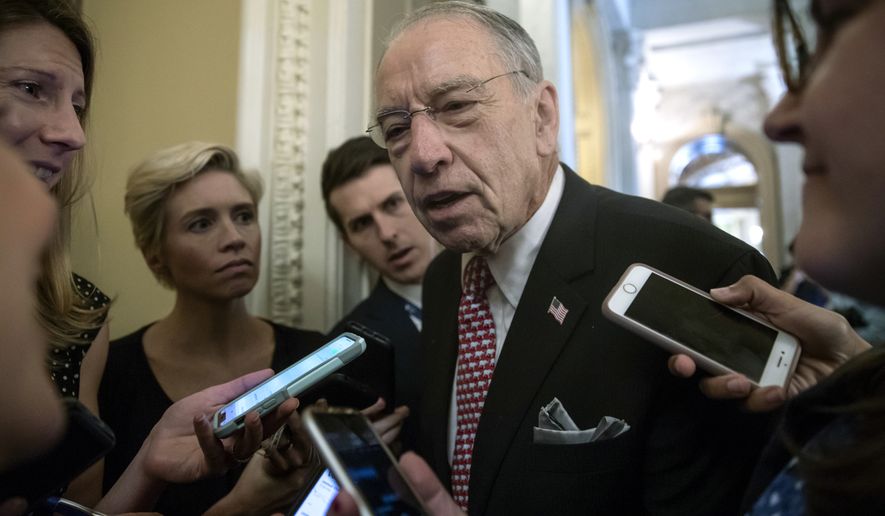A key group of lawmakers has struck a deal to double the number of visas doled out to temporary seasonal guest workers each year, suggesting a breakthrough on an immigration issue that’s bedeviled Congress for years.
The number of visas allowed would rise from 66,000 to 132,000 annually. The tradeoff is that businesses hoping to use the H-2B visa program will have to submit to strict checks on their workforce, making sure anyone hired since 2012, and those they hire going forward, are in the country legally, according to a memorandum of understanding seen by The Washington Times.
Staffers for Republican Sens. Thom Tillis of North Carolina, Charles E. Grassley of Iowa and Mike Rounds of South Dakota, as well as Rep. Andy Harris of Maryland, agreed to the terms with the H-2B Workforce Coalition and the Seasonal Employment Alliance.
“Sen. Tillis has been working with his colleagues on ways to ensure America’s small businesses have the temporary, legal workers they need to sustain their business while also making sure there are integrity and accountability measures in place to protect American workers and promote a legal workforce,” Tillis spokesman Daniel Keylin said. “There is broad bipartisan consensus in support of seasonal small businesses and the American workers they employ, and progress is being made on a fair compromise.”
A Senate aide said GOP leaders are aware of the negotiations, and the lawmakers hope to add their plan to the must-pass spending bill looming next week.
That’s a fast timeline, but the spending bills have been the nexus for battling over the size of the H-2B program the past couple of years.
Chris Chmielenski, deputy director at NumbersUSA, which wants stricter limits on foreign workers, said the deal between Republicans and the industry was unusual and worrisome.
“I don’t ever recall seeing a formal agreement between Congressional staff and employers to draft legislation to increase employers’ access to cheap, foreign labor,” he said. “Donald Trump won the White House by running on a pro-American-worker immigration message, but his party lost control of the House during the midterms by abandoning that message. This agreement is evidence that Republicans haven’t learned from their recent election losses.”
While most of the heat in the immigration debate has been over those in the country illegally, some industries say they’re starving for workers and must have access to foreigners.
That’s particularly true for seasonal non-agriculture workers, which is what H-2B visas are dedicated to. Heavy users include resort-based businesses, landscapers and seafood-processing plants.
The 66,000 annual visas are divided, with half doled out for the winter season and half for the summer.
Under the terms of the deal struck by the lawmakers and the industry the increase in visas would be effective retroactive to Oct. 1.
Businesses would have a year to certify that they are verifying their new hires through E-Verify, the federal government’s currently voluntary system for checking workers’ identities.
The businesses would then have additional years to go back and check the rest of their workers who were hired June 15, 2012, or later. That date corresponds to the beginning of President Obama’s DACA deportation amnesty for illegal immigrant “Dreamers.”
For any illegal immigrants sniffed out during the back-verification process, the businesses who hired them would be allowed to hire a new H-2B worker who wouldn’t count against the caps.
Businesses helping areas struck by natural disasters would also be allowed to bring in workers and not count them against the cap under the deal, which would be retroactive to Oct. 1.
The number of visas issued under the H-2B program has fluctuated wildly over the last 15 years, peaking at nearly 130,000 in 2007, dipping to fewer than 45,000 just two years later, then rising back to between 83,000 and 85,000 in 2016 and 2017.
Those last two years were each above the current 66,000 cap, after fierce fighting earned a temporary reprieve on Capitol Hill.
In 2017, for example, H-2B backers had pushed for a major increase each time, but the most they were able to win was a clunky solution, attached to the annual spending bills, that left it up to the Trump administration to decide how many more visas to offer.
Then-Homeland Security Secretary John Kelly allowed a 15,000-visa hike, but complained that Congress should be the one setting that number.
Even after that chiding, Congress failed to strike a deal for 2018, again leaving it to the Homeland Security secretary — now Kirstjen Nielsen — to settle on an increase. She again offered just 15,000 new visas.
The new congressional deal taking shape appears to be an effort to head off another embarrassing punt.
Having Mr. Grassley on board this time around could be crucial.
The Iowa Republican is chairman of the Judiciary Committee and was a vocal critic of Congress’s decision to allow for the boost in visas the last two years. In letters to Homeland Security he said large corporations take advantage of the program, undercutting American workers. He even warned of human trafficking and labor abuses stemming from the H-2B program.
For his part Mr. Harris, whose Maryland district includes a number of crab-picking and other seaside resort businesses that make use of the workers, signaled he was eager to get something done.
“In the current environment of low unemployment, we need to make sure that we have enough H-2B visas to keep our economy going strong,” Mr. Harris said. “I hope that we can solve the problem with these visas before the next hiring season, especially for our seafood processing and tourism industries in my district.”
Mr. Rounds’ office didn’t respond to repeated inquiries.
• Stephen Dinan can be reached at sdinan@washingtontimes.com.




Please read our comment policy before commenting.